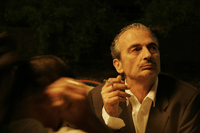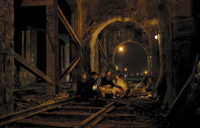 Before I Forget, 2007. If there is a kindred spirit to Jacques Nolot’s film, a stark and brooding portrait of aging, mortality, and loneliness, it is probably Ventura Pons’s contemporary film, Barcelona (A Map), a rumination on architecture and empty spaces as a reflection of internalized, decaying emotional landscapes. This internal struggle is uncompromisingly laid bare in the film’s opening sequence, as a restless and convulsive Pierre Pruez (Jacques Nolot), wracked with pain from his failing health and struggling with the side effects of his HIV medication, rises from his bed to vomit on the bathroom sink, before mechanically taking another tablet to quell his nausea. A ruggedly handsome, well-heeled former gigolo who once cruised the red light district of Pigalle with such notable figures as critic and philosopher Roland Barthes, Pierre, now aging, estranged from friends (usually fellow hustlers who navigated through the same social circles in their youth), and financially insecure after having separated from his benefactor, Toutoune (Albert Mainella) years earlier, approaches twilight of his life with a somber defiance, penning his memoirs in his self-created isolation. Forced into increasingly humiliating situations by his paid young lover, Marc (Bastien d’Asnières), repeatedly cut short at potential breakthrough moments by his inattentive psychiatrist (David Kessler) during their therapy sessions (only to be offered superficial advice as a remedy for his despair), disinherited by Toutoune’s estate when his former benefactor dies intestate (his will having curiously disappeared in the days before his death), and learning of his pragmatic friend, Georges’s (Jean Pommier) success in obtaining an inheritance for an ex-convict and escort, Bruno (Bruno Moneglia) after a benefactor’s death, Pierre’s life has been reduced to a series of transactions that provide a semblance of connection. In this respect, the film also evokes Robert Bresson’s Une Femme deuce in the way companionship and intimacy are negotiated and commodified, where even grocery deliveries and lunch dates equally serve as excuses for fleeting intimacy as reflections of their implied role within the relationship (in one humorous encounter, Georges boasts of his bargain hunting abilities in procuring a young companion at half the price that Pierre pays Marc, and offers to arrange an introduction). Curiously, it is within this intersection of commodity and intimacy that Nolot similarly finds kinship with Pons’s film, closing with the idiosyncratic image of the protagonist in drag that neither reflects a social perversion nor self-mortification, but rather, an act of reinvention, libertine defiance, and reasserted identity.
Before I Forget, 2007. If there is a kindred spirit to Jacques Nolot’s film, a stark and brooding portrait of aging, mortality, and loneliness, it is probably Ventura Pons’s contemporary film, Barcelona (A Map), a rumination on architecture and empty spaces as a reflection of internalized, decaying emotional landscapes. This internal struggle is uncompromisingly laid bare in the film’s opening sequence, as a restless and convulsive Pierre Pruez (Jacques Nolot), wracked with pain from his failing health and struggling with the side effects of his HIV medication, rises from his bed to vomit on the bathroom sink, before mechanically taking another tablet to quell his nausea. A ruggedly handsome, well-heeled former gigolo who once cruised the red light district of Pigalle with such notable figures as critic and philosopher Roland Barthes, Pierre, now aging, estranged from friends (usually fellow hustlers who navigated through the same social circles in their youth), and financially insecure after having separated from his benefactor, Toutoune (Albert Mainella) years earlier, approaches twilight of his life with a somber defiance, penning his memoirs in his self-created isolation. Forced into increasingly humiliating situations by his paid young lover, Marc (Bastien d’Asnières), repeatedly cut short at potential breakthrough moments by his inattentive psychiatrist (David Kessler) during their therapy sessions (only to be offered superficial advice as a remedy for his despair), disinherited by Toutoune’s estate when his former benefactor dies intestate (his will having curiously disappeared in the days before his death), and learning of his pragmatic friend, Georges’s (Jean Pommier) success in obtaining an inheritance for an ex-convict and escort, Bruno (Bruno Moneglia) after a benefactor’s death, Pierre’s life has been reduced to a series of transactions that provide a semblance of connection. In this respect, the film also evokes Robert Bresson’s Une Femme deuce in the way companionship and intimacy are negotiated and commodified, where even grocery deliveries and lunch dates equally serve as excuses for fleeting intimacy as reflections of their implied role within the relationship (in one humorous encounter, Georges boasts of his bargain hunting abilities in procuring a young companion at half the price that Pierre pays Marc, and offers to arrange an introduction). Curiously, it is within this intersection of commodity and intimacy that Nolot similarly finds kinship with Pons’s film, closing with the idiosyncratic image of the protagonist in drag that neither reflects a social perversion nor self-mortification, but rather, an act of reinvention, libertine defiance, and reasserted identity.
 A Wonderful World, 2006. A drunken vagrant, Juan Pérez’s (Damián Alcázar) unexpected turn in fortune after sneaking into an office at the World Financial Center headquarters one cold and rainy evening sets the stage for Luis Estrada’s A Wonderful World, a dense, darkly comic, and provocative, if mean-spirited sardonic fairytale on the politics of poverty, charity, globalization, and social reform. Scurrying out the window to avoid being seen, Pérez discovers that he has been locked out when the janitor secures the office after his cleaning rounds. Now stranded on the ledge on the eve of the finance minister Lascuraian’s (Antonio Serrano) landmark speech to the international community declaring that there are no longer any poor people in Mexico, the sight of the disheveled Pérez raving incoherently on the front façade of the building immediately captures the attention of the opposition press, who believe that his boorish attempts to draw attention to himself are the desperate cries of a man brought to the end of his tether by poverty. Seeking to make headlines and impress his hard-nosed editor (Pedro Armendáriz Jr.), a young reporter (Carlos Arau) embellishes Pérez’s passing comment and reframes his misadventure as the iconic image of the government’s failed policies. But when Pérez becomes an overnight cause célèbre in the newspaper’s call for social reform, he soon finds himself courted by Lascuraian’s own political operatives who see his support as a means of discrediting the opposition. Juxtaposing saturated tones and soft lighting that create the appearance of vintage film with contemporary themes of exclusion, marginalization, and disposability ushered by the global economy, Estrada presents the intrinsic fallacy of globalization in its engendering of social polarization. However, inasmuch as Estrada’s indictment of institutional power proves relevant and impassioned – political exploitation by both left and right wing factions, religious hypocrisy, geopolitical meddling, and entrenched bourgeois values – the film’s tendencies toward stereotyping and caricature in its injections of humor (most egregiously, in the portrayal of the poor as grimy, lazy, and oversexed drunkards) ultimately serves to dilute the film’s potency, obscuring more fundamental issues of class stratification and socioeconomic genocide with facile illustrations of an exaggerated national character.
A Wonderful World, 2006. A drunken vagrant, Juan Pérez’s (Damián Alcázar) unexpected turn in fortune after sneaking into an office at the World Financial Center headquarters one cold and rainy evening sets the stage for Luis Estrada’s A Wonderful World, a dense, darkly comic, and provocative, if mean-spirited sardonic fairytale on the politics of poverty, charity, globalization, and social reform. Scurrying out the window to avoid being seen, Pérez discovers that he has been locked out when the janitor secures the office after his cleaning rounds. Now stranded on the ledge on the eve of the finance minister Lascuraian’s (Antonio Serrano) landmark speech to the international community declaring that there are no longer any poor people in Mexico, the sight of the disheveled Pérez raving incoherently on the front façade of the building immediately captures the attention of the opposition press, who believe that his boorish attempts to draw attention to himself are the desperate cries of a man brought to the end of his tether by poverty. Seeking to make headlines and impress his hard-nosed editor (Pedro Armendáriz Jr.), a young reporter (Carlos Arau) embellishes Pérez’s passing comment and reframes his misadventure as the iconic image of the government’s failed policies. But when Pérez becomes an overnight cause célèbre in the newspaper’s call for social reform, he soon finds himself courted by Lascuraian’s own political operatives who see his support as a means of discrediting the opposition. Juxtaposing saturated tones and soft lighting that create the appearance of vintage film with contemporary themes of exclusion, marginalization, and disposability ushered by the global economy, Estrada presents the intrinsic fallacy of globalization in its engendering of social polarization. However, inasmuch as Estrada’s indictment of institutional power proves relevant and impassioned – political exploitation by both left and right wing factions, religious hypocrisy, geopolitical meddling, and entrenched bourgeois values – the film’s tendencies toward stereotyping and caricature in its injections of humor (most egregiously, in the portrayal of the poor as grimy, lazy, and oversexed drunkards) ultimately serves to dilute the film’s potency, obscuring more fundamental issues of class stratification and socioeconomic genocide with facile illustrations of an exaggerated national character.
Joy Division, 2007. Grant Gee frames the documentary of seminal band Joy Division as a city symphony that mirrors Manchester’s revitalization – a convergence of musicians and friends coming of age during the city’s decline from its heights as the cornerstone of the Industrial Revolution, as equally marked by the rebellious angst of a vibrant punk music scene and the groundbreaking modernist fiction of writers such as William S. Burroughs and Franz Kafka, as they were by the constant flux of their grim environment under the repressive conservatism of the Tory party government headed by Margaret Thatcher (a figurative social institutionalization that, as Peter Hook suggests, was reflected in the area’s wide-scale construction of high-density housing to replace war-era ruins, as well as dilapidated houses that fell to neglect with the economic downturn). For local artists, this environment of institutionalization and decay, mass production and commodification would shape the hard edged, ambient (and often, electronically tinged) industrial sound of Factory Records, a homegrown, independent record label founded by charismatic television personality Tony Wilson and Alan Erasmus, and by the creative team of record producer Martin Hannett and graphic artist Peter Saville, that intrinsically captured the pulse of the city’s deprivation, chaos, and angst. Composed of archival and home video performance footage, written annotations from Ian Curtis’s wife, Deborah, and assorted, talking head interviews with former band members (Bernard Sumner, Stephen Morris, and Peter Hook), Tony Wilson, Peter Saville, industry critics, as well as Curtis’s then-mistress, Belgian journalist Annik Honoré, Gee’s articulate and understated approach to charting the trajectory of the band and its troubled lead singer serves to demythologize Curtis’s enigmatic persona – from the band’s inauspicious origins as an imitative, controversy-courting punk band, to an early photo shoot with rock photographer Anton Corbijn that would provide the group’s iconic images, to the critical and commercial success of their first album, Unknown Pleasures, to the stress of Curtis’s separation from his young family caused by the demands of touring and international fame that would lead to his increasingly violent bouts of epileptic seizures. Gee’s astute incorporation of overlapping images, layering, and stitching (especially between Curtis’s subdued television performances and his more spastic, autonomic trances during live shows) creates a sense of continuum that paradoxically underscores the film’s themes of transformation and passage, even as it presents Curtis’s death as a momentary, tragic act of human frailty, crystallizing an ephemeral moment when music captured the emotional landscape of an anonymous and disposable city and rehabilitated its wounded soul.
 Wolfsbergen, 2007. On the surface, the stationary, extended long take of a desolate, tree-lined woods, the unhurried opening shot of Nanouk Leopold’s Wolfsbergen (channelling a sublimated naturalism that recalls Andrei Tarkovsky’s The Sacrifice and Carlos Reygadas’s Silent Light), seems disconnected from the film’s succeeding, fragmented images of the quotidian. In one episode, a middle-aged woman, Maria (Catherine ten Bruggencate) travels out of the country to have a cosmetic procedure secretly performed, and is unsettled by a letter read during her return flight. The clinical images of the cosmetic surgeon’s examining room is subsequently reflected in the shot of a middle-aged man, Ernst (Jan Decleir) briefly resting in the examination chair of his dental office before the arrival of his next patient. In another episode, lovers Sabine (Tamar van den Dop) and Micha (Oscar van Wounsel) sit in familiar silence post coitus, before parting for the afternoon. Their silent, unaffected intimacy is similarly evoked in the image of an emotionally fragile violinist, Eva (Karina Smulders) who looks on as a former lover flirts openly with a fellow musician during rehearsal. In still another episode, a contrite adolescent girl, Haas (Merel van Houts) helps her mother pick up the shards of broken tableware that she has dropped on the floor. Soon, the connection between these isolated characters emerge – Maria and her husband Ernst, their daughters Sabine and Eva, Sabine’s husband Onno (Fedja van Huêt) and lover Micha, Sabine and Onno’s daughters Haas and Zilver (Carmen Lith) – reluctantly brought together by the family patriarch, Konraad (Piet Kamerman) after he declares his intention of committing suicide on the anniversary of his wife’s death. Hewing towards Jaime Rosales’s Solitary Fragments (released in the same year), Leopold similarly integrates episodic, fragmented narrative, compartmentalization, and obstructed shots (often framed through doorways or against occluding objects) as a visual reinforcement of the characters’ estrangement and emotional fracture. However, while Solitary Fragments uses bifurcated narratives as a means of illustrating converging emotional states, the bifurcations in Wolfsbergen are symptomatic of their own internalized fissures (a dysfunction that is harrowingly reflected in Haas’s unconscious act of self-mutilation during her parents’ argument). It is this self-destruction and emotional starvation that is poignantly embodied in Konraad’s chosen method of suicide – an abstinence of water – that, like Tsai Ming-liang’s recurring images of water, reflects an elemental human need for connection and intimacy.
Wolfsbergen, 2007. On the surface, the stationary, extended long take of a desolate, tree-lined woods, the unhurried opening shot of Nanouk Leopold’s Wolfsbergen (channelling a sublimated naturalism that recalls Andrei Tarkovsky’s The Sacrifice and Carlos Reygadas’s Silent Light), seems disconnected from the film’s succeeding, fragmented images of the quotidian. In one episode, a middle-aged woman, Maria (Catherine ten Bruggencate) travels out of the country to have a cosmetic procedure secretly performed, and is unsettled by a letter read during her return flight. The clinical images of the cosmetic surgeon’s examining room is subsequently reflected in the shot of a middle-aged man, Ernst (Jan Decleir) briefly resting in the examination chair of his dental office before the arrival of his next patient. In another episode, lovers Sabine (Tamar van den Dop) and Micha (Oscar van Wounsel) sit in familiar silence post coitus, before parting for the afternoon. Their silent, unaffected intimacy is similarly evoked in the image of an emotionally fragile violinist, Eva (Karina Smulders) who looks on as a former lover flirts openly with a fellow musician during rehearsal. In still another episode, a contrite adolescent girl, Haas (Merel van Houts) helps her mother pick up the shards of broken tableware that she has dropped on the floor. Soon, the connection between these isolated characters emerge – Maria and her husband Ernst, their daughters Sabine and Eva, Sabine’s husband Onno (Fedja van Huêt) and lover Micha, Sabine and Onno’s daughters Haas and Zilver (Carmen Lith) – reluctantly brought together by the family patriarch, Konraad (Piet Kamerman) after he declares his intention of committing suicide on the anniversary of his wife’s death. Hewing towards Jaime Rosales’s Solitary Fragments (released in the same year), Leopold similarly integrates episodic, fragmented narrative, compartmentalization, and obstructed shots (often framed through doorways or against occluding objects) as a visual reinforcement of the characters’ estrangement and emotional fracture. However, while Solitary Fragments uses bifurcated narratives as a means of illustrating converging emotional states, the bifurcations in Wolfsbergen are symptomatic of their own internalized fissures (a dysfunction that is harrowingly reflected in Haas’s unconscious act of self-mutilation during her parents’ argument). It is this self-destruction and emotional starvation that is poignantly embodied in Konraad’s chosen method of suicide – an abstinence of water – that, like Tsai Ming-liang’s recurring images of water, reflects an elemental human need for connection and intimacy.
 The Duchess of Langeais (Ne touchez pas le hache), 2007. Jacques Rivette returns to the rigorous formalism and claustrophobic interiors of La Religeuse to create a refined, bituminous, and cooly smoldering tale of seduction, obsession, and manners. Remaining faithful to the spirit of Honoré de Balzac’s nineteenth century novel (the second installment featuring the adventures of a secret organization known as the Thirteen), the film, nevertheless retains the imprint of Rivette’s recurring preoccupations with the stage, performance, conspiracy, and malleable time. In The Duchess of Langeais, the tell-tale signal for the start of the performance is cleverly concealed behind the rakish military officer and Napoleonic war hero, Armand de Montriveau’s (Guillaume Depardieu) impatient tapping of his cane during mass at a remote Spanish cloister, sullenly registering his displeasure at not being able to catch a glimpse of Las Descalzas, the barefoot nuns of St. Theresa, during services. Having arrived at the desolate peninsula on the Mediterranean after sailing to the ends of the earth over the past five years in search of his lost love, a Parisian aristocrat named Antoinette de Langeais (Jeanne Balibar), Montriveau is quick to dispense with formalities and exploit his influence in order to obtain a meeting with the order’s sole French initiate who, accompanied by a Spanish-speaking chaperone, seems willing to consent to Montriveau’s request for an audience by claiming him as her brother (note the reinforcement of the theater image in the parting of curtains that separate the cloistered nuns from the outside world). However, when Antoinette exposes the ruse in order to escape Montriveau’s desperate entreaties, he is forced to confront the ghosts of their unreconciled past as he hatches a plan to liberate her from her spiritual captivity and compel her to return to face their impossible destiny. In presenting Antoinette and Montriveau’s courtship as a choreography of performance, mise-en-scène (especially in Antoinette’s feigned illness during one appointment, adjusting the room’s lighting and accoutrements that reinforce their encounters as exercises in role-playing), and timing (in Antoinette’s insistence on punctuality that provides the irony – and denouement – for their uncoupling), Rivette creates a potent metaphor for performance as both a mask and a nakedness, where the impenetrability of the human heart is exposed through frustrated, arbitrary rituals and untenable desire.
The Duchess of Langeais (Ne touchez pas le hache), 2007. Jacques Rivette returns to the rigorous formalism and claustrophobic interiors of La Religeuse to create a refined, bituminous, and cooly smoldering tale of seduction, obsession, and manners. Remaining faithful to the spirit of Honoré de Balzac’s nineteenth century novel (the second installment featuring the adventures of a secret organization known as the Thirteen), the film, nevertheless retains the imprint of Rivette’s recurring preoccupations with the stage, performance, conspiracy, and malleable time. In The Duchess of Langeais, the tell-tale signal for the start of the performance is cleverly concealed behind the rakish military officer and Napoleonic war hero, Armand de Montriveau’s (Guillaume Depardieu) impatient tapping of his cane during mass at a remote Spanish cloister, sullenly registering his displeasure at not being able to catch a glimpse of Las Descalzas, the barefoot nuns of St. Theresa, during services. Having arrived at the desolate peninsula on the Mediterranean after sailing to the ends of the earth over the past five years in search of his lost love, a Parisian aristocrat named Antoinette de Langeais (Jeanne Balibar), Montriveau is quick to dispense with formalities and exploit his influence in order to obtain a meeting with the order’s sole French initiate who, accompanied by a Spanish-speaking chaperone, seems willing to consent to Montriveau’s request for an audience by claiming him as her brother (note the reinforcement of the theater image in the parting of curtains that separate the cloistered nuns from the outside world). However, when Antoinette exposes the ruse in order to escape Montriveau’s desperate entreaties, he is forced to confront the ghosts of their unreconciled past as he hatches a plan to liberate her from her spiritual captivity and compel her to return to face their impossible destiny. In presenting Antoinette and Montriveau’s courtship as a choreography of performance, mise-en-scène (especially in Antoinette’s feigned illness during one appointment, adjusting the room’s lighting and accoutrements that reinforce their encounters as exercises in role-playing), and timing (in Antoinette’s insistence on punctuality that provides the irony – and denouement – for their uncoupling), Rivette creates a potent metaphor for performance as both a mask and a nakedness, where the impenetrability of the human heart is exposed through frustrated, arbitrary rituals and untenable desire.
Acquarello, 2008 [reprinted]